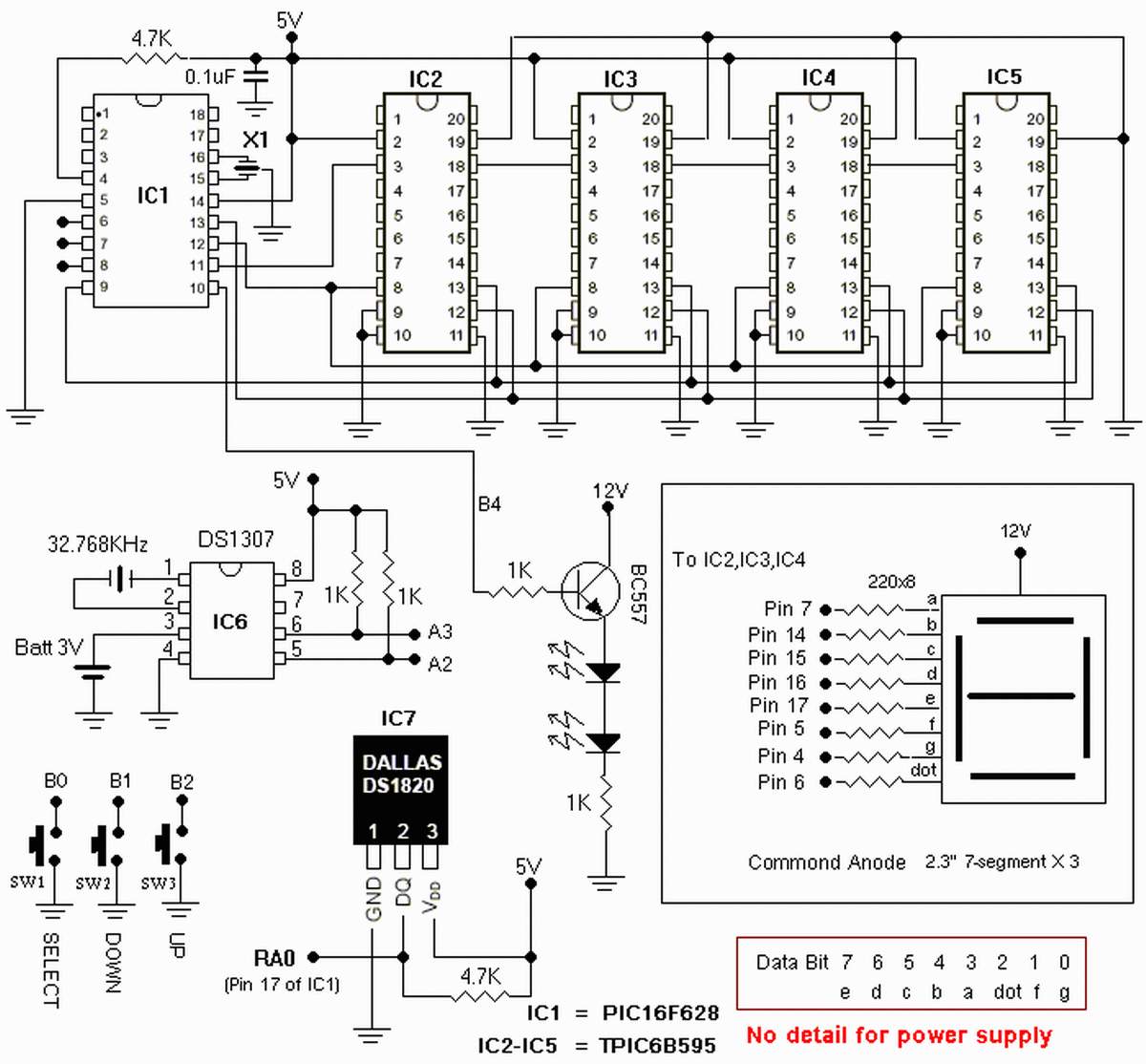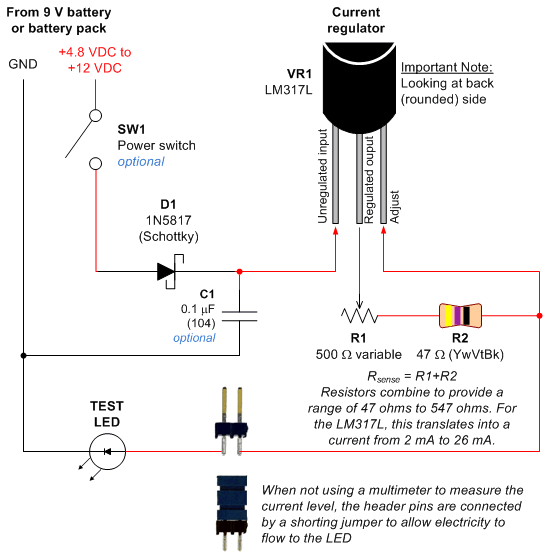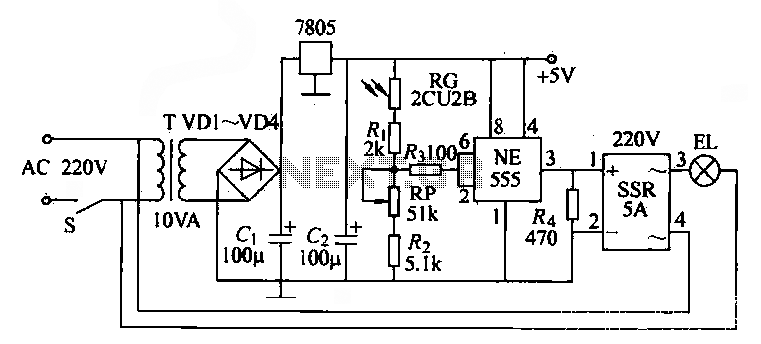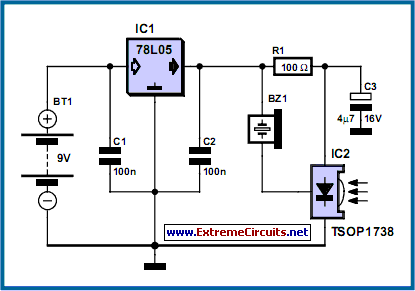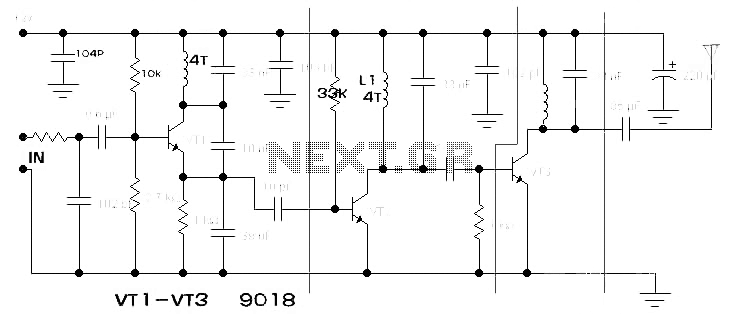
Transistor tester circuit
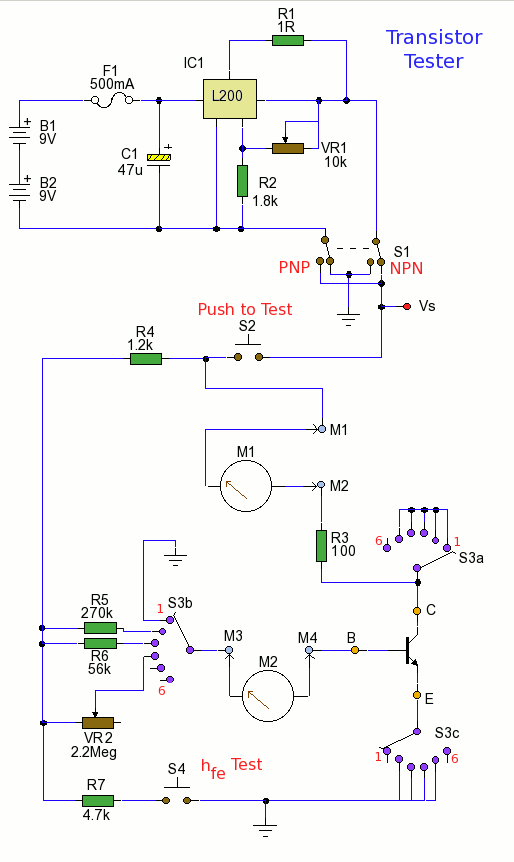
Using the tester is straightforward. Begin with the power off and insert a transistor into the test socket. Set switch S1 for either NPN or PNP configuration and rotate switch S3 to the desired test position. Adjust variable resistor VR1 to achieve the required collector-emitter voltage. Pressing switch S2 allows for the measurement of hFE. Pressing S2 along with S4 enables hFE measurement as well. Detailed usage instructions follow. With S3 in position 1, insert a transistor into the test socket and set S2 for NPN or PNP. M3 and M4 should be shorted, and a multimeter set to DC microamps between M1 and M2 will allow for the measurement of collector-base leakage current. Silicon transistors may not show any reading, while germanium transistors will exhibit measurable leakage current. Set S1 for NPN or PNP and rotate S3 to position 2. Adjust VR1 so the power supply reads 6 volts between terminal Vs and ground. Short M3 and M4, and connect a digital multimeter set to measure DC milliamps across M1 and M2. Pressing S2 will now allow the measurement of hFE, calculated as the meter reading divided by 20 uA. For position 3, repeat the process with the power supply set to 6 volts, and the hFE will be the meter reading divided by 100 uA. In position 4, hFE varies with different collector currents and temperatures, and VR1 and VR2 allow for the setup of different operating points. For a circuit powered by a 15 Vdc supply with a base current of 15 uA, first set VR1 to read 15 volts between terminal Vs and ground. Short M1 and M2, and use a digital multimeter set to measure DC microamps across M3 and M4. Press S2 and adjust VR2 until 15 uA is measured between M3 and M4. Upon releasing S2, short terminals M3 and M4, remove the link across M1 and M2, and set the meter to read DC milliamps. Pressing S2 will allow for hFE measurement, calculated as the meter reading divided by the chosen base current. With S3 in position 5, insert a transistor into the test socket, set S2 for NPN or PNP, short M3 and M4, and use a multimeter set to DC microamps to measure collector-emitter leakage current. The circuit can also measure the small signal current gain hfe for base currents of approximately 20 uA, 100 uA, or any specific operating point. Follow previous steps for DC current gain measurement, ensuring the voltage Vs is set to 6 volts, and short M3 and M4 before pressing S2 to read the current across terminals M1 and M2. This reading will be designated as IC1. While keeping S2 pressed, also press S4 to record the reading as IC2. hFE can be measured at any operating point within the voltage and current range of the power supply, which can deliver 18 volts at up to 500 mA. For higher currents, a bench power supply is recommended to avoid draining batteries. To measure hFE at a VCE of 12 volts and collector current of 1 mA, adjust VR1 to set the supply Vs at 12 volts. Short M3 and M4, press S2, and connect a multimeter to M1 and M2, adjusting VR2 to read 1 mA. After releasing S2, short M1 and M2, remove the short from M3 and M4, and set the meter to microamps to measure the current. Record both base and collector currents. Press S2 and S4 again to measure both currents. The value of hFE is calculated as the difference in collector current divided by the difference in base current. The small signal AC current gain can be obtained by varying the base current. When S4 is pressed, the input voltage is reduced by the fraction R7 / (R4 + R7), which decreases the input base current. The change in collector current divided by the change in base current defines hFE. The difference in base current is calculated as 92.6 uA - 72.8 uA = 19.8 uA, which serves as the denominator for the larger change in collector current. The distinction between hFE and hfe is often minimal, allowing one value to substitute for the other. Data sheets typically provide the DC current gain hFE, while hfe represents the AC quantity, which decreases at higher frequencies. This circuit measures the change in base current at DC, thus the hfe value will only be approximate at low frequencies up to 1 kHz. To measure hfe at a specific frequency, a signal generator is required, with the meter configured to measure AC base and collector currents. Although the circuit is simple, the wiring of the switch may present challenges. If a variable power supply, multimeter, and breadboard are available, the circuit can be set up as described.
The described circuit is a transistor tester designed to measure key parameters such as DC current gain (hFE) and small-signal current gain (hfe) of transistors. It includes a test socket for inserting the transistor, a power supply adjustable via VR1, and a series of switches (S1, S2, S3, and S4) for selecting transistor type and test conditions. The circuit utilizes a multimeter to measure various current levels, enabling users to evaluate the transistor's performance under different configurations and operating points.
The setup allows for the measurement of leakage currents, base currents, and collector currents, with the ability to adjust for different transistor types (NPN or PNP) and conditions (silicon or germanium). The design accommodates a range of power supply voltages and currents, making it versatile for various testing scenarios. The inclusion of variable resistors (VR1 and VR2) provides flexibility in establishing the necessary operating points for accurate measurements.
In practice, the circuit's effectiveness hinges on proper calibration and the use of quality components to ensure reliable readings. The use of a digital multimeter enhances measurement accuracy, while the straightforward design facilitates ease of use for electronics enthusiasts and professionals alike. Overall, this transistor tester is an essential tool for evaluating and characterizing transistors in various electronic applications.Using the tester is easy, starting with power off, insert a transistor into the test socket. Set S1 for NPN or PNP androtate S3 to the required test position. Rotate VR1 so the desired collector emitter voltage. Pressing S2 now allows the measurement of hFE to be made. Pressing S2 and S4 allows hfe to be measured. More detailed usage now follows. With S3 in position 1, insert a transistor into the test socket and set S2 for NPN or PNP. M3 and M4 need to be shorted and a multimeter set to DC microamps between M1 and M2 now allows collector base leakage current to be measured. With silicon transistors, you may not see a reading at all, but germanium transistors have leakage current which can be measured.
Set S1 for NPN or PNP and rotate S3 to position 2. Rotate VR1 so the power supply reads 6 Volt between terminal Vs and ground. Place a shorting link across M3 and M4 and a digital multimeter set to measure DC lamps across M1 and M2. Pressing S2 now allows the measurement of hFE to be made. This will be the meter reading / 20 uA. Set S1 for NPN or PNP and rotate S3 to position 3. Rotate VR1 so the power supply reads 6 Volt between terminal Vs and ground. Place a shorting link across M3 and M4 and a digital multimeter set to measure DC milliamps across M1 and M2.
Pressing S2 now allows the measurement of hFE to be made. This will be the meter reading / 100 uA. Set S1 for NPN or PNP and rotate S3 to position 4. The parameter hFE varies with different collector currents and temperatures. VR1 and VR2 allow you to set up different operating points. Suppose you have a circuit where a transistor is run from a 15 Vdc supply and base current is 15 uA. First set VR1 so the power supply reads 15 Volt between terminal Vs and ground. Place a shorting link across M1 and M2 and a digital multimeter set to measure DC microamps across M3 and M4. Press S2 and adjust VR2 until 15 uA is measured between M3 and M4. Now release S2, short terminals M3 and M4, remove the link across M1 and M2 and set the meter to read DC milliamps.
Pressing S2 now allows the measurement of hFE to be made. This will be the meter reading / 15 uA (or whatever base current you choose). With S3 in position 5, insert a transistor into the test socket and set S2 for NPN or PNP. M3 and M4 need to be shorted and a multimeter set to DC microamps between M1 and M2 now allows collector emitter leakage current to be measured. With silicon transistors, you may not see a reading at all, but germanium transistors have leakage current which can be measured.
The value of the small signal current gain hfe can also be measured with this circuit, for base currents of approximately 20uA, 100uA or any particular operating point. Proceed as in the previous steps for measuring DC current gain and with S3 at position 2, 3, or 4. The voltage Vs should be set to 6 Volt, a short across meter terminals M3 and M4 is required then press S2 and read the current on the meter across terminals 1 and 2.
This reading will be called IC1. Now keeping S2 pressed, also press S4, record the reading, this is measurement IC2. You can also measure hfe at any operating point within the voltage and current range of the power supply. The power supply can deliver 18 Volts at up to 500mA. Larger currents will drain the batteries so a bench power supply would be recommended. To measure hfe at a VCE of 12 Volts and collector current 1 mA. First adjust VR1 so that the supply Vs is 12 Volt. Short M3 and M4, press S2 and connect a multimeter to M1 and M2 and adjust VR2 to read 1 mA. Now release S2, short M1 and M2 and remove the short on M3 and M4 and set your meter to microamps and measure the current.
Record both values of base and collector current. Now press S2 and S4 and measure both collector and base currents again. The value of hfe is the difference in collector current divided by the difference in base current. The small signal AC current gain is achieved by changing the value of the base current. When S4 is pressed, the input voltage is reduced by the fraction R7 / (R4+R7) which reduces the input base current. hfe is the change in collector current divided by the change in base current. The base current which is calculated as follows: The difference in base current is therefore 92. 6uA - 72. 8uA = 19. 8uA This value is then used as the denominator forthe larger change in collector current, as in the previous section.
In practice, the difference between hFE and hfe is often so small that one value can be substituted for the other. Data sheets invariably quote the value for the dc current gain hFE, the parameterhfe is the ac quantity and decreases also at higher frequency.
As this circuit measures the change in base current at dc the value of hfe will only be approximate at low frequencies up to 1kHz. To measure hfe at a particular frequency, then a signal generator would be required and the meter set to measure ac base and collector currents.
Although simple, the wiring of the switch can be troublesome, and if you already have a variable power supply, multimeter and a breadboard, then you can set up the circuit as shown below: In my test transistor, a BC109C Base current was 94. 6 uA. The power supply was set at 6V and a 56k and 1. 2k resistor wired in series. Next the collector current was measured, see below: 🔗 External reference
The described circuit is a transistor tester designed to measure key parameters such as DC current gain (hFE) and small-signal current gain (hfe) of transistors. It includes a test socket for inserting the transistor, a power supply adjustable via VR1, and a series of switches (S1, S2, S3, and S4) for selecting transistor type and test conditions. The circuit utilizes a multimeter to measure various current levels, enabling users to evaluate the transistor's performance under different configurations and operating points.
The setup allows for the measurement of leakage currents, base currents, and collector currents, with the ability to adjust for different transistor types (NPN or PNP) and conditions (silicon or germanium). The design accommodates a range of power supply voltages and currents, making it versatile for various testing scenarios. The inclusion of variable resistors (VR1 and VR2) provides flexibility in establishing the necessary operating points for accurate measurements.
In practice, the circuit's effectiveness hinges on proper calibration and the use of quality components to ensure reliable readings. The use of a digital multimeter enhances measurement accuracy, while the straightforward design facilitates ease of use for electronics enthusiasts and professionals alike. Overall, this transistor tester is an essential tool for evaluating and characterizing transistors in various electronic applications.Using the tester is easy, starting with power off, insert a transistor into the test socket. Set S1 for NPN or PNP androtate S3 to the required test position. Rotate VR1 so the desired collector emitter voltage. Pressing S2 now allows the measurement of hFE to be made. Pressing S2 and S4 allows hfe to be measured. More detailed usage now follows. With S3 in position 1, insert a transistor into the test socket and set S2 for NPN or PNP. M3 and M4 need to be shorted and a multimeter set to DC microamps between M1 and M2 now allows collector base leakage current to be measured. With silicon transistors, you may not see a reading at all, but germanium transistors have leakage current which can be measured.
Set S1 for NPN or PNP and rotate S3 to position 2. Rotate VR1 so the power supply reads 6 Volt between terminal Vs and ground. Place a shorting link across M3 and M4 and a digital multimeter set to measure DC lamps across M1 and M2. Pressing S2 now allows the measurement of hFE to be made. This will be the meter reading / 20 uA. Set S1 for NPN or PNP and rotate S3 to position 3. Rotate VR1 so the power supply reads 6 Volt between terminal Vs and ground. Place a shorting link across M3 and M4 and a digital multimeter set to measure DC milliamps across M1 and M2.
Pressing S2 now allows the measurement of hFE to be made. This will be the meter reading / 100 uA. Set S1 for NPN or PNP and rotate S3 to position 4. The parameter hFE varies with different collector currents and temperatures. VR1 and VR2 allow you to set up different operating points. Suppose you have a circuit where a transistor is run from a 15 Vdc supply and base current is 15 uA. First set VR1 so the power supply reads 15 Volt between terminal Vs and ground. Place a shorting link across M1 and M2 and a digital multimeter set to measure DC microamps across M3 and M4. Press S2 and adjust VR2 until 15 uA is measured between M3 and M4. Now release S2, short terminals M3 and M4, remove the link across M1 and M2 and set the meter to read DC milliamps.
Pressing S2 now allows the measurement of hFE to be made. This will be the meter reading / 15 uA (or whatever base current you choose). With S3 in position 5, insert a transistor into the test socket and set S2 for NPN or PNP. M3 and M4 need to be shorted and a multimeter set to DC microamps between M1 and M2 now allows collector emitter leakage current to be measured. With silicon transistors, you may not see a reading at all, but germanium transistors have leakage current which can be measured.
The value of the small signal current gain hfe can also be measured with this circuit, for base currents of approximately 20uA, 100uA or any particular operating point. Proceed as in the previous steps for measuring DC current gain and with S3 at position 2, 3, or 4. The voltage Vs should be set to 6 Volt, a short across meter terminals M3 and M4 is required then press S2 and read the current on the meter across terminals 1 and 2.
This reading will be called IC1. Now keeping S2 pressed, also press S4, record the reading, this is measurement IC2. You can also measure hfe at any operating point within the voltage and current range of the power supply. The power supply can deliver 18 Volts at up to 500mA. Larger currents will drain the batteries so a bench power supply would be recommended. To measure hfe at a VCE of 12 Volts and collector current 1 mA. First adjust VR1 so that the supply Vs is 12 Volt. Short M3 and M4, press S2 and connect a multimeter to M1 and M2 and adjust VR2 to read 1 mA. Now release S2, short M1 and M2 and remove the short on M3 and M4 and set your meter to microamps and measure the current.
Record both values of base and collector current. Now press S2 and S4 and measure both collector and base currents again. The value of hfe is the difference in collector current divided by the difference in base current. The small signal AC current gain is achieved by changing the value of the base current. When S4 is pressed, the input voltage is reduced by the fraction R7 / (R4+R7) which reduces the input base current. hfe is the change in collector current divided by the change in base current. The base current which is calculated as follows: The difference in base current is therefore 92. 6uA - 72. 8uA = 19. 8uA This value is then used as the denominator forthe larger change in collector current, as in the previous section.
In practice, the difference between hFE and hfe is often so small that one value can be substituted for the other. Data sheets invariably quote the value for the dc current gain hFE, the parameterhfe is the ac quantity and decreases also at higher frequency.
As this circuit measures the change in base current at dc the value of hfe will only be approximate at low frequencies up to 1kHz. To measure hfe at a particular frequency, then a signal generator would be required and the meter set to measure ac base and collector currents.
Although simple, the wiring of the switch can be troublesome, and if you already have a variable power supply, multimeter and a breadboard, then you can set up the circuit as shown below: In my test transistor, a BC109C Base current was 94. 6 uA. The power supply was set at 6V and a 56k and 1. 2k resistor wired in series. Next the collector current was measured, see below: 🔗 External reference
Warning: include(partials/cookie-banner.php): Failed to open stream: Permission denied in /var/www/html/nextgr/view-circuit.php on line 713
Warning: include(): Failed opening 'partials/cookie-banner.php' for inclusion (include_path='.:/usr/share/php') in /var/www/html/nextgr/view-circuit.php on line 713
